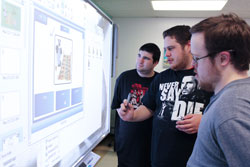The University implemented an emergency remote learning period for the first week of the spring semester amid a surge of COVID cases in Monmouth County, as indicated in an email from President Patrick Leahy Ed.D. on Friday, Jan. 7.
“For an emergency period of Tuesday, Jan. 18 through Monday, Jan. 24, all classes will migrate to an online format. By shifting to emergency remote learning for this discrete period, we hope to mitigate the risk of exposure among our community,” wrote Leahy. “Our goal through these updated plans is to limit the spread of the virus early in the semester in order to preserve an in-person experience throughout the remainder of the academic year.”
In his email, Leahy explained that he had been working with the senior leadership team to communicate with the Monmouth County Regional Health Commission about the latest COVID updates. In these conversations, public health officials indicated that the Omicron variant was likely to peak in mid-January, followed by a decline in positive cases and transmission rate. Faculty, staff, and student leadership groups worked together to respond accordingly.
“It is our intent to return to in-person instruction, but that may be subject to a variety of circumstances,” wrote Leahy.
Mary Ann Nagy, Vice President for Student Life and Leadership Engagement, explained how family gatherings during the holiday season contributed to an expected uptick in COVID cases and the impact this had on the University’s plans for the spring semester.
“When we looked at the number of cases we were already hearing about and where we were starting the semester in relation to Christmas and New Years, we decided that going online for the first week made the most sense because it allowed us to implement a test-to-return requirement,” explained Nagy.
Students living on campus in residence halls were required to provide evidence of a negative test taken within 72 hours of their assigned move-in date. Those who had the virus over the break were asked to provide proof of a positive test occurring between 90 and 10 days prior to move-in.
“If you happened to be one of the students, and there were many, who got sick over the holidays and you provided us the proof that you were sick, we allowed you to enter the residence halls because we know that for about 90 days you could potentially test positive again,” explained Nagy.
“We felt that the one week was sufficient for us to be able to achieve what we were trying to achieve, which was easing back into the semester instead of rushing right into it,” said Nagy. “When you think about the residence halls, we have as many as 1,600 students there. You want them to start coming in in smaller numbers. We began the process of moving students back in on the fourteenth of January, and gradually all through that weekend and into the next week.”
Kathy Maloney, Director of Health Services, expressed that although pre-arrival testing has been successful in preventing COVID positive students from moving into residence halls, it does not take commuter students into consideration and does not prevent the two groups from intermixing and infecting one another. “It holds it at bay for a week or two. We’ll get a good start to the semester,” she predicted.
Beyond surveillance entry testing, the University has continued to implement various mitigation strategies based on recommendations from the CDC, the New Jersey Department of Health, and the Office of the Secretary of Higher Education in New Jersey. This includes maintaining three feet distance in classrooms, implementing an indoor masking mandate, requiring vaccines and boosters, and conducting both symptomatic and asymptomatic testing.
Masking has continued to play an integral role in slowing the spread of COVID through the University community. “There was a point where people started to question the masking piece as we got lulled into that little period of September and October where there were low COVID cases. It was great, and then all of the sudden things started ticking up,” said Maloney. “The most important thing is to have everybody stay masked in the classroom. It’s the single best protection because you decrease transmission when everyone is wearing a mask. Throughout this whole pandemic, we did not have in-classroom outbreaks. Why? Because we maintained masks.”
The University plans to keep a masking mandate in place until positivity rates decline. “We knew that omicron was surging in New Jersey, and it still is,” said Maloney. “We’re on the down slope, but that being said, 10,000 people still tested positive in New Jersey yesterday. That’s still better than the 33,000 in one day that it was several weeks ago. Numbers are coming down, but they’re still high.”
Nagy emphasized the importance of capitalizing upon this decline and not letting COVID cases increase again. “We have to stay on top of that decline as much as we can to be able to keep the semester going,” she explained.
Ultimately, the University’s main goal is to conduct classes in person for the duration of the semester. Various health and safety protocols have been implemented in order to mitigate the spread of COVID and have been successful in doing so thus far.
“Let’s get through the winter and see what spring brings for us,” said Maloney. “We will get through this semester just as we’ve done for the other semesters as we’re learning to live with COVID.”



